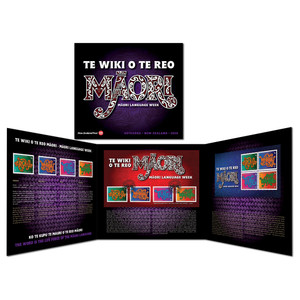The Māori people brought the beginnings of their art with them from their ancient homeland in Polynesia when they migrated to New Zealand more than 1000 years ago. In their new, remote home in the South Pacific, away from outside influences, they developed those beginnings to new plateaus over successive generations. Wood carving was the primary art form but it was just one of the Māori's cultural accomplishments. Māori art ranged from carving meeting houses and other buildings, war canoes and weapons - to creating clothing and personal ornaments such as burial chests, musical instruments, treasure boxes, marvellous cloaks and skirts.
Issue information
Almost nothing that the Māori made was without decoration of some sort. They used a wide variety of materials, from readily available and workable timber, flax, bone and whale-bone ivory to the less tractable greenstone, argillite and basalt. They practised and experimented in a range of styles from formalisation through impressionism to the near abstract. Generally speaking, Māori art was, and still is, largely a question of shape and design rather than colour.
Traditional Māori arts flourish today although new materials, tools and international influences have introduced an added new dimension to traditional design. Twentieth century technology produced these stamp designs - all are original images created on the computer screen and are therefore not aligned to any specific tribal area but are representative of Māori culture as a whole.
Product Listing for Māori Crafts
Click on image to enlarge.
| Image | Title | Description | Price |
|---|---|---|---|
 |
Single Stamp |
Single 40c 'Kete (Basket)' gummed stamp. Māori women wove baskets for everyday use and little time was spent on ornamentation - although trouble was taken with the small baskets made to hold valuable objects. The more elaborate kits with woven geometric patterns are a modern innovation. The various types of basket were woven from flax or durable cabbage tree leaves. Flax leaves were dried over a fire so they would not shrink. Baskets were neatly finished by turning them inside out so protruding ends would not show. Plaited loop handles were fastened to the sides. The kete is an utilitarian carry-all which comes in a wide variety of shapes and sizes. |
$0.40 |
 |
Single Stamp |
Single 80c 'Taiaha (Weapon)' gummed stamp. Before the Europeans arrived in New Zealand, bringing guns with them, Māori warriors fought hand to hand, either in skirmishes or in pitched battle. Necessarily they developed a wide range of personal weapons for combat. Approaching two metres in length the taiaha was made of hardwood with a carved head and pointed tongue (the carved head is illustrated on the stamp). The weapon was used much like a quarter-staff or two-handed sword. |
$0.80 |
 |
Single Stamp |
Single $1.00 'Tāniko (Embroidery)' gummed stamp. The geometric patterns of taniko feature coloured triangles, zigzags, and other rectilinear elements combining to form a unique series of patterns. This intricate craft is chiefly used to decorate clothing. The handcraft encompassed weaving and hand-dyed fibres. |
$1.00 |
 |
Single Stamp |
Single $1.20 'Pounamu (Greenstone)' gummed stamp. Greenstone or jade, found mainly on the west coast of the South Island, was an important barter item in the Māori economy. It occurs in colour variations from black through green to milky white. Blocks of the material were broken down and transformed by laborious cutting and grinding into personal items of great beauty and value. Modern tools and methods have enabled craft workers to produce a wider range of designs and shapes. |
$1.20 |
 |
Single Stamp |
Single $1.50 'Hue (Gourd)' gummed stamp. The dried fruits of the gourd plant, brought to New Zealand from the ancestral homeland of the Māori, were put to a wide range of everyday uses from water bottles to storage containers. The soft inner material was removed to leave the hard rind or outer skin. Wooden mouthpieces or spouts were frequently added. Many gourds were decorated by scratching or incising the outer surface. This example has curved patterns of the koru type. The koru features on the background of five of these stamps and is incorporated in the taniko pattern on the $1.00 value. |
$1.50 |
 |
Single Stamp |
Single $1.80 Korowai (Cloak)' gummed stamp. Māori women were the expert weavers and their superb sense of style and decoration reached great heights in the production of clothing, especially cloaks. Among them were feather-decorated cloaks, mourning cloaks, ceremonial cloaks and finely woven cloaks with coloured borders or taniko. Most garments had a woven flax base. Superior cloaks were works of art and much time was devoted to their production. Cloaks featuring kiwi feathers and the brilliant red feathers of the underwings of the kaka were particularly prized. |
$1.80 |
 |
First Day Cover | First day cover with stamps affixed. Cancelled on the first day of issue. | $6.95 |
 |
Set of Maximum Cards | Set of six pre-paid souvenir cards featuring a stamp on the front and artwork from the stamp issue. | $7.95 |
 |
Presentation Pack | Presentation pack containing a selection of stamp products from the issue and further information on the theme of the stamps. | $8.50 |
 |
Limited Edition | Limited Edition collectable containing exclusive stamp products not available anywhere else. | $135.00 |

Technical information
| Date of issue: | 21 February 1996 |
|---|---|
| Designer: | George Hubbard and Rongotai Lomas, Auckland,New Zealand |
| Printers: | Stamps: Joh Enschedé, Netherlands; Miniature Sheet: Southern Colour Print, New Zealand |
| Stamp size: | 35mm x 40.5mm; Miniature Sheet Size: 110mm x 130mm |
| Sheet sizes: | 50 Stamps per sheet; Miniature Sheet of three stamps |
| Process: | Lithography |
| Perforation gauge: | 13.25 x 13.75; Miniature Sheet: 13 |
| Paper type: | Red phosphor coated, unwatermarked |
| Period of sale: | These stamps remained on sale until 21 February 1997. |


